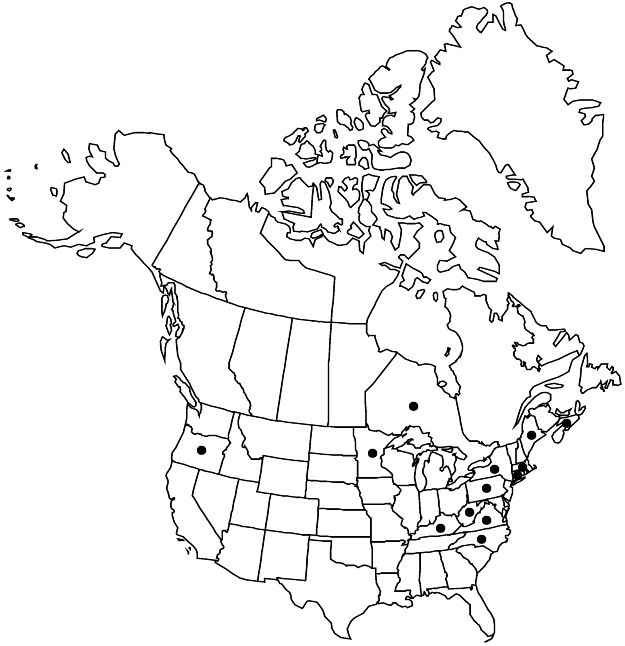Difference between revisions of "Rubus illecebrosus"
Abh. Naturwiss. Vereine Bremen 16: 278. 1899.
FNA>Volume Importer |
imported>Volume Importer |
||
| (2 intermediate revisions by 2 users not shown) | |||
| Line 28: | Line 28: | ||
|elevation=0–1200 m | |elevation=0–1200 m | ||
|distribution=N.S.;Ont.;Conn.;Ky.;Maine;Mass.;Minn.;N.Y.;N.C.;Oreg.;Pa.;Va.;W.Va.;e Asia;introduced also in South America (Colombia;Paraguay;Venezuela). | |distribution=N.S.;Ont.;Conn.;Ky.;Maine;Mass.;Minn.;N.Y.;N.C.;Oreg.;Pa.;Va.;W.Va.;e Asia;introduced also in South America (Colombia;Paraguay;Venezuela). | ||
| + | |introduced=true | ||
|discussion=<p><i>Rubus illecebrosus</i> is distinguished from other raspberries by its prickly, glabrous, eglandular stems, pinnately compound leaves with typically seven lanceolate to narrowly ovate leaflets, relatively large flowers, white petals, and 50–100 drupelets.</p> | |discussion=<p><i>Rubus illecebrosus</i> is distinguished from other raspberries by its prickly, glabrous, eglandular stems, pinnately compound leaves with typically seven lanceolate to narrowly ovate leaflets, relatively large flowers, white petals, and 50–100 drupelets.</p> | ||
|tables= | |tables= | ||
| Line 52: | Line 53: | ||
|publication year=1899 | |publication year=1899 | ||
|special status=Introduced | |special status=Introduced | ||
| − | |source xml=https:// | + | |source xml=https://bitbucket.org/aafc-mbb/fna-data-curation/src/2e0870ddd59836b60bcf96646a41e87ea5a5943a/coarse_grained_fna_xml/V9/V9_54.xml |
|subfamily=Rosaceae subfam. Rosoideae | |subfamily=Rosaceae subfam. Rosoideae | ||
|tribe=Rosaceae tribe Rubeae | |tribe=Rosaceae tribe Rubeae | ||
Latest revision as of 22:57, 5 November 2020
Shrubs, 5–10(–15) dm, armed. Stems annual, arching to mounding, glabrous, eglandular, not pruinose; prickles sparse, slightly hooked, stout, 3–4 mm, broad-based. Leaves deciduous, pinnately compound; stipules lanceolate to oblanceolate, 8–13 mm; leaflets (3–)5–7, terminal lanceolate to narrowly ovate, (5.5–)6.2–8.5(–9.7) × (1.8–)2.2–3(–4.2) cm, base usually rounded, sometimes truncate to subcordate, unlobed, margins finely to coarsely doubly serrate, apex acuminate, abaxial surfaces with prickles on midvein, glabrous, eglandular. Inflorescences solitary flowers or 2–3-flowered clusters. Pedicels: prickles sparse, slightly hooked, glabrous, eglandular. Flowers bisexual; petals white, broadly obovate to suborbiculate, 12–15(–18) mm; filaments laminar; ovaries glabrous, styles glabrous. Fruits red, oblong, 1.4–2 cm; drupelets 50–100, strongly coherent, separating from torus. 2n = 14.
Phenology: Flowering Jun–Sep.
Habitat: Disturbed sites
Elevation: 0–1200 m
Distribution

Introduced; N.S., Ont., Conn., Ky., Maine, Mass., Minn., N.Y., N.C., Oreg., Pa., Va., W.Va., e Asia, introduced also in South America (Colombia, Paraguay, Venezuela).
Discussion
Rubus illecebrosus is distinguished from other raspberries by its prickly, glabrous, eglandular stems, pinnately compound leaves with typically seven lanceolate to narrowly ovate leaflets, relatively large flowers, white petals, and 50–100 drupelets.
Selected References
None.